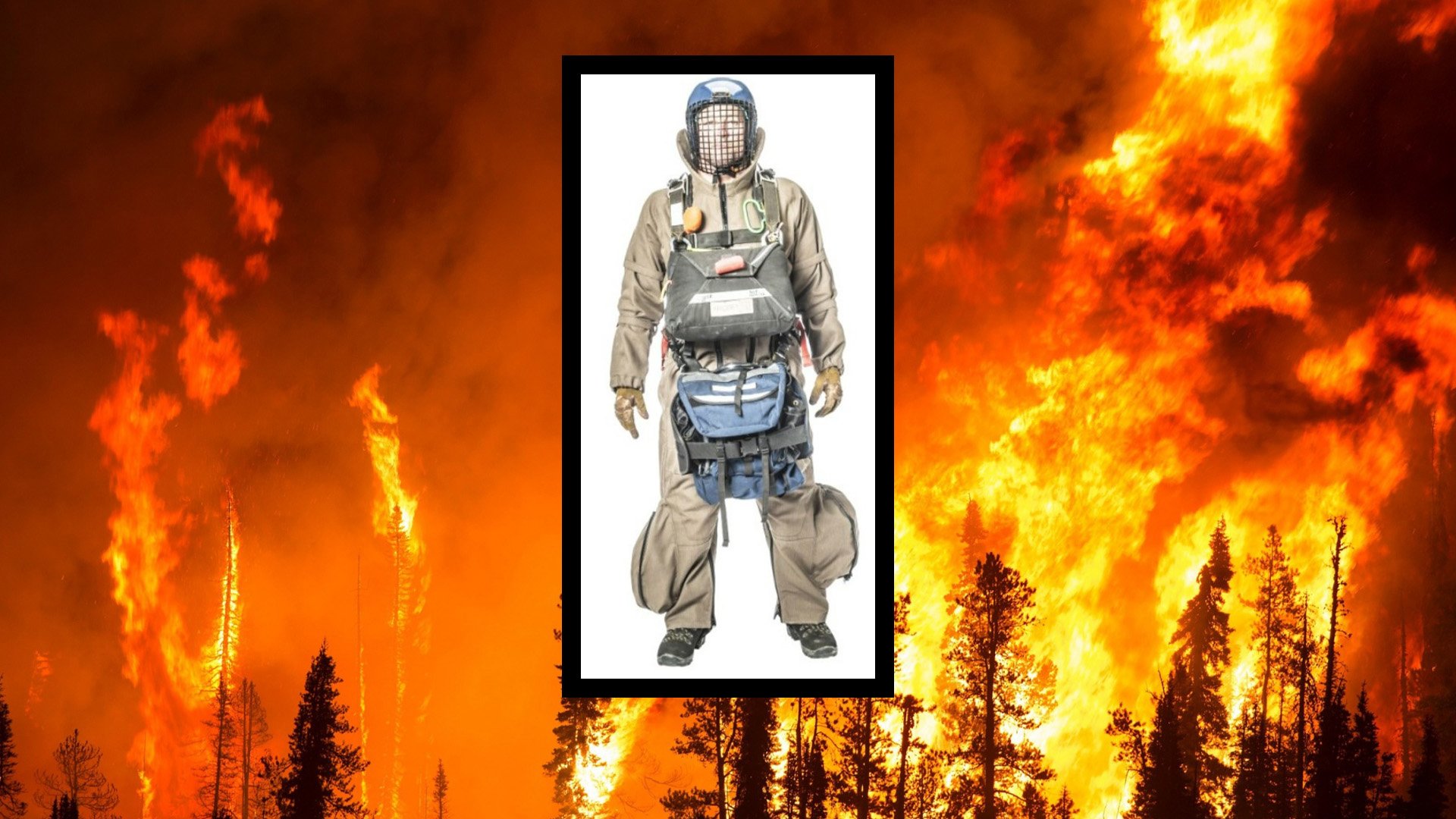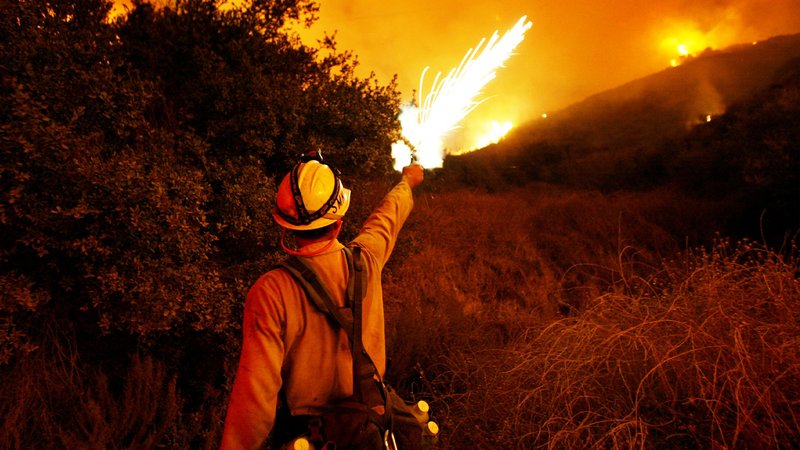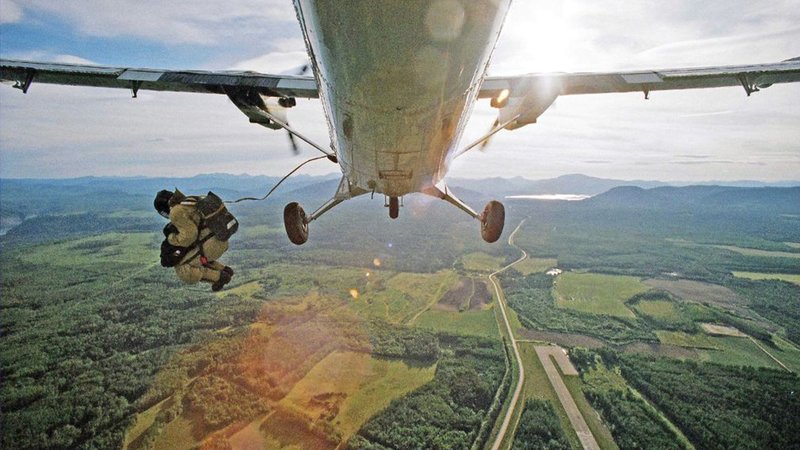Sneak Peek at the New Rough Terrain Jumpsuit for America’s Elite Smokejumpers

US Army Combat Capabilities Development Command Soldier Center, or DEVCOM SC, designed a new Rough Terrain Jumpsuit for America's elite smokejumper firefighters working for the US Department of Agriculture’s Forest Service and the US Department of Interior’s Bureau of Land Management. They parachute into remote areas to extinguish wildfires. Coffee or Die Magazine composite.
When it came time for America’s elite smokejumpers to get new duds, they went to the fashion house famous for bespoke flame-fighting field attire.
They went to the Army’s Combat Capabilities Development Command Soldier Center in Natick, Massachusetts — what the Pentagon calls “DEVCOM SC.” These are the people who create gear for explosive ordnance disposal operators, Green Berets, and everyone else in the mean green fighting machine.
A team of top DEVCOM SC textile and production designers, chemists, and ballistic and blast experts pitched in on a prototype for the smokejumpers’ new rough terrain jumpsuit.
It has two layers: a flame-retardant base and an abrasion-resistant outer shell designed to prevent an aerial firefighter from getting impaled on a tree.
The idea was to use cutting-edge, lightweight materials that could withstand parachuting into forests. It relies on aramid fibers to keep the sun from breaking down the fabric, which will extend the life of the jumpsuit.

Smokejumper Rico Gonzalez shoots flares into the brush to set backfires at the Grand Prix Fire in the pre-dawn hours on Oct. 23, 2003, north of Fontana, California. Photo by David McNew/Getty Images.
Innovative design features include impact resistant foam integrated into the outfit, adjustable side pockets at the bottom of the trousers to stow gear, and a potentially better built-in letdown system, in case a smokejumper gets snagged in a tree.
“We are waiting for the latest prototype to be completed before doing a field evaluation on it,” said Justin “JT” Gilman, the smokejumper equipment specialist for the US Forest Service, in an email to Coffee or Die Magazine. “Hoping to have one in hand by mid-September, at which point we will get a few jumps on it to see if we need to make any further modifications before moving forward with a larger scale field evaluation.”
Because Gilman’s agency worked so closely with the Army’s textile team to create the new uniform, Coffee or Die reached out to him, Nate Hesse, and Zach Glover to ask them about the new togs. The trio spoke as one voice, by email.
Coffee or Die: What led the Forest Service to design a new jumpsuit? When was the old one designed? Did it have an organic letdown system, like the new jumpsuit?
Smokejumpers: The Forest Service is interested in designing a new jumpsuit as part of continual efforts to ensure smokejumpers are outfitted with the best possible protective equipment. The foundational elements of the current design have been around the Smokejumper organization since its inception, however there are frequent design updates and improvements being evaluated. Enlisting the expertise of the [Combat Capabilities Development Command Soldier Center] in this most recent endeavor is an attempt to garner input from outside the Smokejumper program in hopes of fostering fresh ideas and consideration of more modern and innovative textiles which may have not been previously considered. The legacy jumpsuit does incorporate a built-in letdown system; however, the leg pocket it’s housed in has been redesigned for the new edition.

The US Forest Service has roughly 320 smokejumpers who work from seven bases in Idaho, Montana, California, Oregon, and Washington. They usually jump in groups of two. A spotter selects the safest place to jump, and they're followed by cargo boxes containing food, tools, and gear. They remain on the ground until the fire is extinguished or they're ordered out, with aircraft resupplying them. US Forest Service photo.
Coffee or Die: How does the new letdown system work? And why is that important?
Smokejumpers: The letdown system itself isn’t necessarily a part of the jumpsuit redesign effort. There has been some consideration given to the incorporation of a separate pocket within the leg pocket to specifically house the letdown tape. The primary benefit to that would be better distribution of the letdown tape in order to make it less likely to have any effect on the jumpers exit from the aircraft.
Coffee or Die: The new jumpsuit is supposed to be lighter and to offer more range of motion. How much lighter does it feel? How has it improved the range of motion? What, for example, would you need that range of motion to do that the old uniforms kept you from doing?
Smokejumpers: The new jumpsuit is designed to integrate more form fitting aftermarket protective padding that is used in high impact sports and utilizes updated abrasion and flame-resistant fabrics in its construction. The experts at [Combat Capabilities Development Command Soldier Center] were able to analyze the protective and abrasion resistant properties of the padding and fabrics and determine the optimum placement and protective levels needed throughout the suit, and where less material could be utilized. This allows for a more fitted jumpsuit that is lighter weight and has increased mobility.
While enroute to the fire, increased mobility will be advantageous where the smokejumpers must maneuver to do equipment checks, gain situational awareness on the jump conditions and the fire area, and safely exit the aircraft, all in a hot, noisy, and cramped jumpship. Under canopy, increased mobility will benefit the jumper in performing in flight maneuvers, emergency procedures, parachute landing falls (PLF), and in some instances, letdowns out of trees. Smokejumpers frequently pack their gear out of the backcountry, which can weigh as much as 140 pounds, so any weight and bulk savings that could be realized would be a welcomed improvement.

The US Bureau of Land Management has roughly 150 smokejumpers based in Idaho and Alaska. Bureau of Land Management photo.
Coffee or Die: How many smokejumpers participated in the program to develop a new jumpsuit? What input did they give? How did they test the new jumpsuit?
Smokejumpers: The entire smokejumper program is to some degree involved with the development of a new jumpsuit, however ideas and concepts are typically filtered down through the loft departments at individual bases and then on to the two Smokejumper Equipment Specialist positions at the National Technology and Development Program (NTDP) in Missoula, Montana. For this particular endeavor, there has been one primary smokejumper, Zach Glover from McCall, Idaho, working in collaboration with NTDP for the duration of the project.
Coffee or Die: What are the Goldilocks pockets like? What would you put in them?
Smokejumpers: The “Goldilocks” pockets are an adaptation of the historically used leg pockets. Depending on the particular compliment of gear the jumper decides to bring with them, there is oftentimes extra space in the leg pocket. In an effort to better streamline the jumpsuit, [Combat Capabilities Development Command Soldier Center] came up with the concept of making the volume of the pocket customizable by having options to restrict the pockets capacity with zippers. Leg pockets typically store the letdown system, miscellaneous clothing, and occasionally a tent.
Read Next: Indiana Woman Hit With Max Sentence for Shooting Trooper

Carl Prine is a former senior editor at Coffee or Die Magazine. He has worked at Navy Times, The San Diego Union-Tribune, and Pittsburgh Tribune-Review. He served in the Marine Corps and the Pennsylvania Army National Guard. His awards include the Joseph Galloway Award for Distinguished Reporting on the military, a first prize from Investigative Reporters & Editors, and the Combat Infantryman Badge.
BRCC and Bad Moon Print Press team up for an exclusive, limited-edition T-shirt design!
BRCC partners with Team Room Design for an exclusive T-shirt release!
Thirty Seconds Out has partnered with BRCC for an exclusive shirt design invoking the God of Winter.
Lucas O'Hara of Grizzly Forge has teamed up with BRCC for a badass, exclusive Shirt Club T-shirt design featuring his most popular knife and tiomahawk.
Coffee or Die sits down with one of the graphic designers behind Black Rifle Coffee's signature look and vibe.
Biden will award the Medal of Honor to a Vietnam War Army helicopter pilot who risked his life to save a reconnaissance team from almost certain death.
Ever wonder how much Jack Mandaville would f*ck sh*t up if he went back in time? The American Revolution didn't even see him coming.
A nearly 200-year-old West Point time capsule that at first appeared to yield little more than dust contains hidden treasure, the US Military Academy said.












